Types of Swords
Throughout human history, swords have been more than just weapons; they have been symbols of power, honor, and martial prowess. From the battlefields of medieval Europe to the courts of feudal Japan, swords have played a pivotal role in shaping cultures and histories. These bladed weapons, renowned for their versatility and deadly precision, evolved across the world in various forms to meet the unique demands of different regions and combat styles. Types of Swords remain an iconic representation of martial strength, artistry, and craftsmanship, even as modern warfare has shifted to firearms and mechanized weapons.
You may be interested in this article. Ottoman Swords: A Fascinating Legacy of Power and Craftsmanship
Why Swords Were Essential
Swords were designed to be a warrior’s most reliable weapon, perfectly balancing cutting, thrusting, and defensive capabilities. What set them apart from other melee weapons, like maces or spears, was their adaptability. A well-crafted sword could be wielded with deadly precision in both one-on-one combat and large-scale battles. It was versatile enough for offense, defense, and even parrying other weapons. Many civilizations also valued swords as ceremonial items, often used in rituals, coronations, and other formal occasions, symbolizing justice, strength, and leadership.
While their practical battlefield use began to wane with the advent of gunpowder, the cultural and symbolic importance of swords persists. For instance, the katana is still revered in Japanese culture as a symbol of the samurai’s honor, while European swords, such as the longsword or rapier, are celebrated in historical reenactments and fencing competitions
Sword Classification Overview
Swords can be classified based on various criteria, such as their blade type, length, region of origin, and intended use. The main categories include single-edged and double-edged swords, thrusting and slashing swords, and one-handed versus two-handed weapons. For example, the longsword, primarily used in medieval Europe, was designed for two-handed combat, offering both reach and power in battles. In contrast, the rapier, popular during the Renaissance, was designed for one-on-one dueling, favoring thrusting attacks over slashing
Different regions developed distinct types of swords that reflected their martial needs and cultural values. In Japan, the katana became synonymous with the samurai warrior, known for its sharpness and curved blade, which made it ideal for quick, precise strikes. Meanwhile, in the Middle East, curved swords like the scimitar were favored by cavalry for their slashing capabilities. In ancient Rome, the gladius was the weapon of choice for Roman legionaries, perfectly suited for thrusting attacks in close-quarters combat.
This diversity in sword types reflects the adaptability of human ingenuity across various combat styles and environments. Whether designed for slashing on horseback, dueling in court, or cutting through armor on the battlefield, each type of sword was crafted to meet specific tactical requirements, leaving an indelible mark on history.
Detailed Types of Swords
Swords have taken on many forms over the centuries, each crafted for specific purposes, regions, and fighting styles. Below, we explore some of the most iconic sword types, delving into their history, design, and role in combat.
1. Longsword
The longsword, also referred to as a “hand-and-a-half sword” or bastard sword, is one of the most iconic weapons from medieval Europe. Known for its versatility, the longsword was primarily used during the late Middle Ages and Renaissance period, particularly in the 14th and 15th centuries.
- Key Features: The longsword typically had a double-edged blade, averaging about 90-110 cm in length, with a hilt designed for two-handed use. This made it particularly effective for delivering powerful strikes while maintaining control. Its weight, ranging from 1.2 to 1.8 kg, allowed it to be agile while also capable of cutting through armor.
- Combat Use: Primarily employed in warfare, the longsword was also used in dueling and ceremonial displays of martial prowess.
2. Zweihander
The Zweihander is a massive two-handed sword used primarily by German mercenaries during the 16th century. This weapon is essentially a larger version of the longsword, but it was wielded in unique circumstances.
- Key Features: Zweihanders were around 1.4 to 2 meters in length, with a blade that could exceed 1 meter. Their substantial size and weight made them unwieldy for typical combat but perfect for certain battle strategies.
- Combat Use: These swords were used to break through enemy pike formations, often carried over the shoulder rather than at the waist. Though largely phased out of combat by the 17th century, they were occasionally used for ceremonial purposes.
3. Rapier
The rapier became widely popular during the Renaissance, primarily as a civilian weapon for dueling rather than battlefield use.
- Key Features: Unlike earlier medieval swords, the rapier was designed with a long, slender, and sharply pointed blade, optimized for thrusting rather than slashing. Rapiers were around 1 meter long, with intricate hilt designs that provided hand protection.
- Combat Use: The rapier’s agility made it perfect for unarmored, one-on-one duels, where speed and precision were more important than sheer power. Its complex hilt design, often elaborate and decorative, became a symbol of status and elegance.
4. Katana
The katana is a single-edged, curved sword traditionally used by samurai in feudal Japan. It emerged during the Kamakura period (12th century) and became central to Japanese martial culture.
- Key Features: Katanas are renowned for their razor-sharp, slightly curved blades, usually between 60 to 80 cm in length. These swords are crafted using advanced metallurgical techniques, combining hard and soft steel to create a weapon that is both sharp and flexible.
- Combat Use: Samurai used the katana for swift, precise strikes, often delivering fatal blows with a single motion. Beyond warfare, the katana held symbolic importance, representing the honor and soul of the samurai.
5. Dao and Jian (Chinese Swords)
China boasts a rich history of swordsmanship, with the Dao and Jian being the most prominent types.
- Dao: The Dao, often referred to as a Chinese saber, is a single-edged sword with a curved blade. First appearing in the Bronze Age, the Dao was used primarily by cavalry and infantry for slashing.
- Jian: The Jian is a double-edged, straight sword dating back to the 7th century BCE. Known as the “gentleman’s sword,” it was valued for its balance between cutting and thrusting capabilities. Jian swords were typically used by scholars and martial artists.
6. Gladius
The gladius was the primary weapon of Roman legionaries, renowned for its effectiveness in close combat.
- Key Features: The gladius was short, around 60 to 80 cm in total length, with a double-edged blade designed for thrusting.
- Combat Use: Roman soldiers used the gladius in combination with their large shields (scutum), making it ideal for stabbing in tightly packed formations. Its design maximized the lethality of Roman infantry.
7. Sabers
Sabers are characterized by their gently curved, single-edged blades, which made them highly effective for cavalry.
- Key Features: Sabers typically had a blade length of 75 to 90 cm, optimized for slashing attacks from horseback.
- Combat Use: Originally derived from Middle Eastern scimitars, sabers became the preferred weapon of cavalry forces across Europe during the 17th century. Their design allowed mounted soldiers to deliver powerful, sweeping cuts.
8. Scimitars and Shamshir
The scimitar and shamshir are curved swords from the Middle East and Persia, respectively.
- Key Features: These swords are known for their deeply curved blades, optimized for slashing.
- Combat Use: Scimitars were favored by cavalry due to their ability to deliver powerful slashing attacks from horseback. The shamshir, with its Persian origins, became known for its lightweight and swift strikes.
9. Xiphos
The Xiphos is an ancient Greek sword, used primarily as a secondary weapon by hoplite warriors.
- Key Features: This short sword had a leaf-shaped blade, typically between 40 to 60 cm in length, making it effective for both slashing and thrusting.
- Combat Use: Greek soldiers used the xiphos in close-quarters combat after their primary spears (dory) became unusable.
10. Talwar
The Talwar is a curved, single-edged sword that originated in India and gained widespread use across the Indian subcontinent. The Talwar became a staple weapon for the Mughal armies and many other Indian warriors.
- Key Features: The Talwar has a distinctive, deeply curved blade, typically around 70 to 80 cm in length, and a disk-shaped pommel that provides excellent grip. This design enables quick, powerful slashing movements, making it highly effective for mounted combat.
- Combat Use: The Talwar’s curved blade allowed soldiers to deliver powerful slashing attacks while riding horseback. It was also used in foot combat by infantrymen and remains a symbol of martial prowess in Indian culture.
11. Claymore
The Claymore is a large, two-handed sword associated with Scotland and was famously wielded by Scottish Highlanders.
- Key Features: The Claymore typically had a straight, double-edged blade ranging from 140 to 180 cm, designed to deliver powerful, sweeping strikes. Its crossguard often featured downward sloping arms that made it recognizable.
- Combat Use: This sword was primarily used during the late medieval and early Renaissance periods, favored by Scottish warriors for its capacity to deliver heavy blows against opponents in battle.
12. Cutlass
The Cutlass is a short, curved sword known for its association with sailors and naval forces during the Age of Sail.
- Key Features: The Cutlass typically had a single-edged blade around 60 to 75 cm in length, with a basket-shaped guard to protect the hand. Its design was compact and highly effective in confined spaces, such as aboard ships.
- Combat Use: Naval officers and pirates used the Cutlass for close combat, especially during boarding actions. Its shorter length and sturdy design made it ideal for quick, slashing attacks.
13. Falchion
The Falchion is a medieval European sword that combines the weight and power of an axe with the versatility of a sword.
- Key Features: Falchions were generally single-edged, with a slightly curved blade and a total length of 70 to 90 cm. They were designed for slashing rather than thrusting, making them excellent against lightly armored opponents.
- Combat Use: The Falchion was popular in the 13th and 14th centuries among European knights and soldiers. It was particularly effective in cutting through mail armor.
14. Ulfberht Swords
Ulfberht Swords were Viking-age swords renowned for their superior craftsmanship and quality, especially in terms of steel.
- Key Features: These swords were double-edged and featured a simple crossguard and a wide blade, optimized for both slashing and thrusting. They were about 85 to 100 cm in length and are notable for the “Ulfberht” inscription found on many blades, which signified the sword’s superior quality.
- Combat Use: These swords were used by elite Viking warriors and were prized for their exceptional strength and sharpness, often compared to modern steel.
Ottoman and Turkish Swords: Symbols of Power and Heritage
The Ottoman Empire, spanning over six centuries, was not only known for its vast territory and military prowess but also for its unique and effective weapons. Among these, Ottoman and Turkish swords hold a prominent place in the history of the region, deeply tied to the warrior culture and the empire’s rise to dominance. These swords were as much about status and ceremony as they were about battlefield utility, with each design reflecting the needs of the time, the geography, and the empire’s expansion.
1. Kilij
The Kilij is perhaps the most iconic sword associated with the Ottoman Empire. It is a single-edged, slightly curved sword known for its devastating cutting ability. The kilij emerged in the 15th century, evolving from earlier Central Asian Turkic sabers, and became a staple weapon for Ottoman cavalry.
- Key Features: The kilij’s defining characteristic is its pronounced curve, which increases towards the tip, making it an ideal weapon for slashing attacks, particularly on horseback. Its design allowed soldiers to deliver powerful strikes while maintaining control of the weapon. The blade often features a yelman, an extended, widened portion near the tip, which added weight and improved cutting efficiency.
- Combat Use: The kilij was predominantly used by Ottoman cavalry, such as the famed Sipahi and Janissaries, in mounted combat. The sword’s curved blade made it extremely effective in slashing down on enemies from horseback. Its design allowed for swift, devastating attacks that were perfect for the open, fast-paced battlefields of the time.
2. Yatagan
The Yatagan is another distinctive sword from the Ottoman period, commonly used from the 16th to 19th centuries. It was primarily a close-combat infantry weapon.
- Key Features: Unlike the kilij, the yatagan has a much straighter blade with a slight forward curve near the tip, typically measuring between 60 to 80 cm in length. Its handle often lacked a guard, but it featured a distinctive, wide, flared pommel, often shaped like a crescent or stylized animal heads.
- Combat Use: The yatagan was most commonly used by Ottoman foot soldiers, particularly the Janissaries. Its forward-curving blade made it effective for both slashing and thrusting in close combat, particularly in the confined, chaotic environment of infantry engagements.
3. Shamshir
Although originally Persian, the Shamshir was widely adopted by the Ottomans and became a significant part of their armory. The shamshir’s design, much like the kilij, was optimized for mounted combat.
- Key Features: The shamshir has a deeply curved, single-edged blade, designed for slashing. The curve of the shamshir is even more pronounced than that of the kilij, making it highly efficient for delivering powerful cuts.
- Combat Use: Used by cavalry, the shamshir was favored for its lightweight design and its efficiency in cutting attacks. Ottoman soldiers, especially mounted ones, prized the shamshir for its ability to deliver lethal strikes without much effort, even from a moving horse.
4. Zulfiqar
The Zulfiqar is a legendary sword in Islamic history and is often associated with the Ottoman Empire due to its cultural and symbolic significance. Traditionally believed to be the sword of Ali, the fourth caliph, the zulfiqar holds a special place in Islamic mythology and art.
- Key Features: The zulfiqar is characterized by its split or forked blade, although historical accuracy of its design is debated. It is often depicted in art and literature as a symbol of justice, heroism, and divine support in battle.
- Cultural Significance: While not widely used as a battlefield weapon in the Ottoman era, the zulfiqar became an important symbol in the empire, particularly for its association with Islamic leadership and heroism.
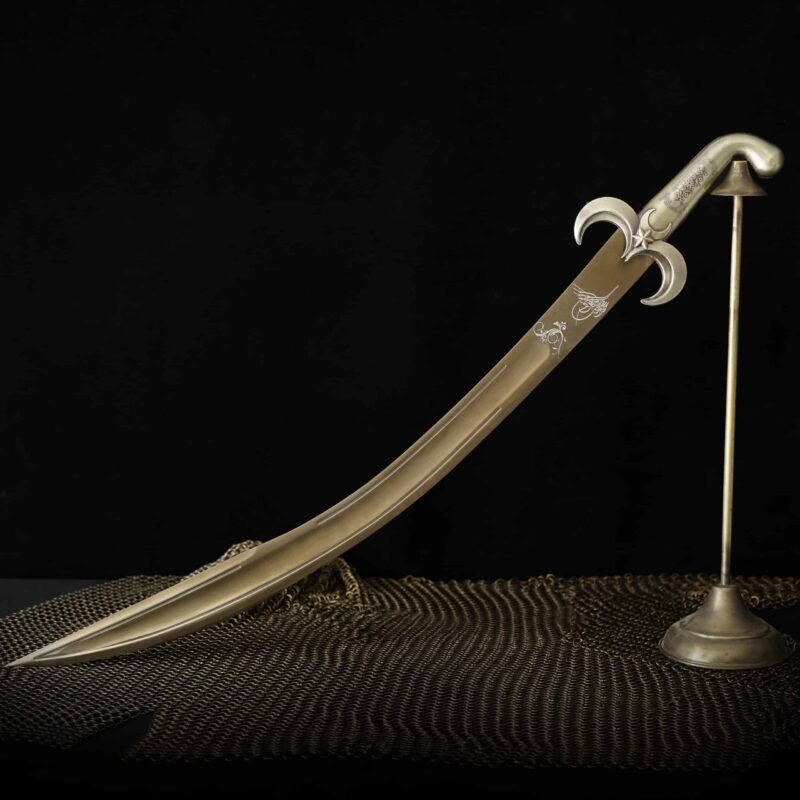

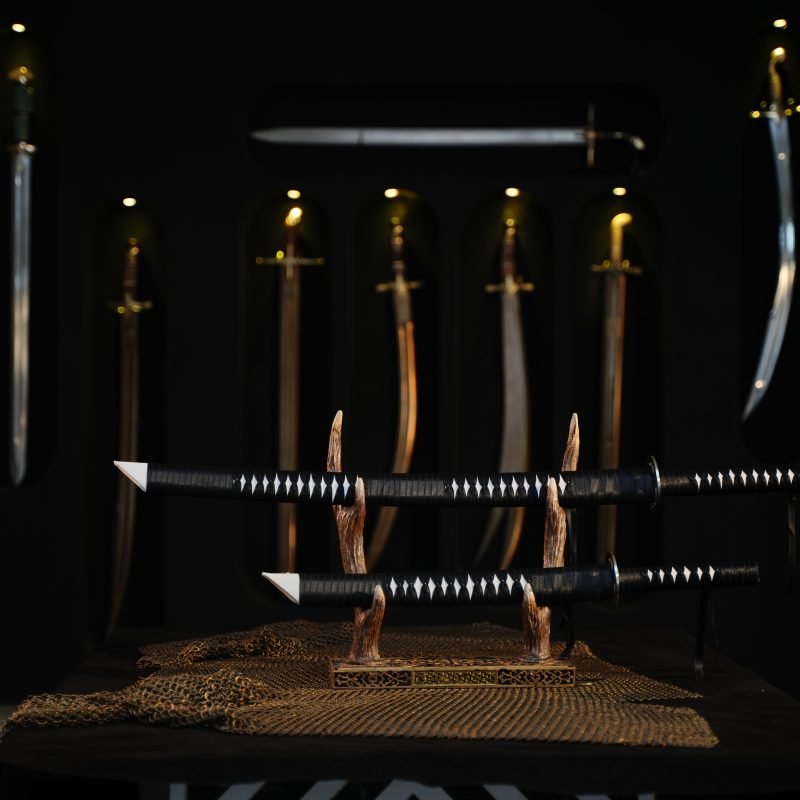


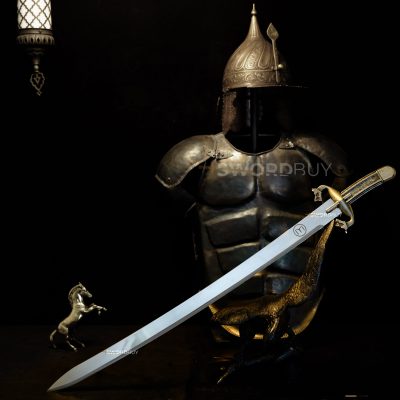

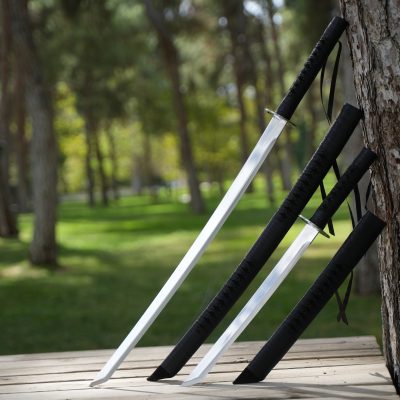


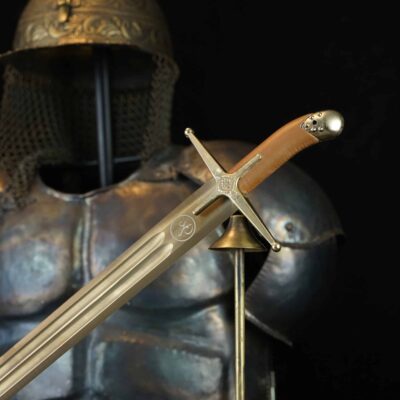











Pingback: Discover the Art of Handmade Custom Swords - SwordBuy
Pingback: Art of Handmade Custom Swords – Types Of Swords